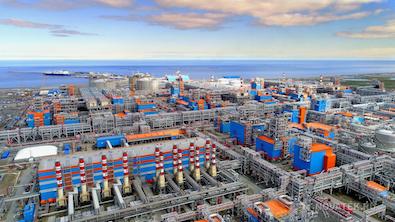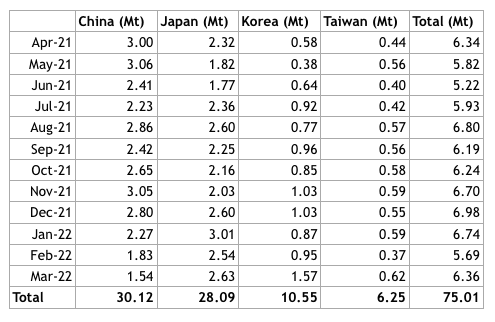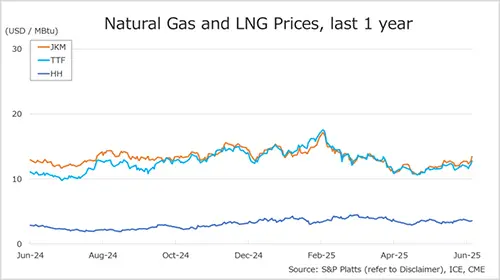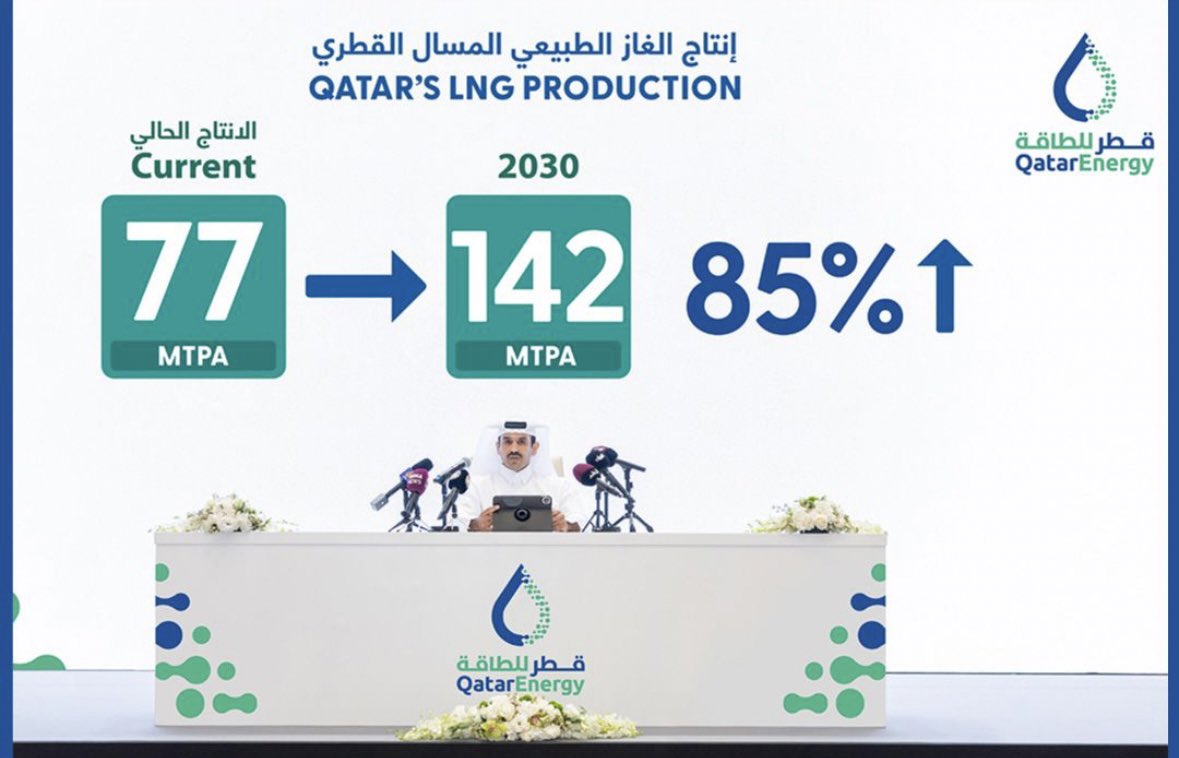

Credit / source / authors: Hiroshi Hashimoto, Yosuke Kunimatsu, Gen Hosokawa, IEEJ
Introduction
The fifth LNG export project in the mainland of the United States and the first with Japanese utility companies’ equity participation – Freeport LNG in Texas – started producing LNG in August 2019. The United States exported 16.10 million tonnes of LNG to the global market in the first half of 2019, an increase of 57% or 5.9 million tonnes from one year earlier.
Another LNG export project announced its effective investment decision. Australia’s LNG shipments in July surpassed 7 million tonnes in 102 cargoes – for the first time to export more than 100 cargoes in one month, after exporting 37 million tonnes in the first half of the year. Japan’s customs statistics showed that the country imported 6.82 million tonnes of LNG in July. During the first seven months of the year the country imported 45.41 million tonnes of LNG, a 7% year-on-year decline. During the same period Korea’s LNG import declined by 10% to 23 million tonnes and Chinese Taipei’s also decreased by 7% to 9.58 million tonnes, resulting in a 6.74 million tonne reduction from the three big LNG importers.
The previous LNG Review mentioned that the European region, including the European Union and Turkey, imported nearly 42 million tonnes in the first half of 2019, surpassing Japan and China. Among supply sources to the European market, LNG from Russia increased notably, as well as LNG from the United States, in the period (LNG exports to Europe from the two sources increased by more than 5 million tonnes each year-on-year). On the other hand, Russian pipeline gas export to Europe amounted to 95.3 bcm in the first half of 2019, decreasing by 5.9%, or 4 million tonnes LNG equivalent, compared to one year earlier.
Asia Pacific
According to Japan’s customs statistics, Japan imported 6.82 million tonnes of LNG in July 2019. During the first seven months of the year, the country imported 45.41 million tonnes of LNG, which was 7% smaller than one year earlier. In July, 70,560 tonnes of LNG was delivered from China at the Chita terminal near Nagoya.
Singapore’s Sinanju Logistics Services entered into a two-year time charter agreement with ExxonMobil for a new-build bunker tanker five months ahead of commencing operations. The 7,990 dwt newbuilding will be the first bunker tanker for Singapore and Sinanju, to be powered mainly by LNG. The tanker will deliver ExxonMobil’s new EMF.5TM Engineered Marine Fuels to ocean-going vessels within Singapore port limits from the first quarter of 2020.
The LNG terminal of First Gen Corporation was declared an energy project of national significance (EPNS) by the Energy Investment Coordination Council (EICC) of the Department of Energy (DOE). In March 2019, FGEN LNG received the formal approval of its application for a notice to proceed (NTP) from the DOE. Meanwhile, Philippines’ Centralized Review and Evaluation Committee (C-REC) of DOE endorsed the issuance of a notice-to- proceed (NTP) for the proposed floating storage regasification unit (FSRU) of Excelerate Energy.
China imported 7.894 million tonnes of natural gas in July 2019 and 54.74 million tonnes during the first seven months of the year, a 10.8% year-on-year increase, according to the customs statistics. According to NDRC (National Development and Reform Commission), China’s natural gas consumption during the first seven months of 2019 increased by 10.9% year-on-year to 174.4 bcm, while its domestic natural gas production increased by 10.3% to 100.1 bcm.
China’s local distribution company Shenzhen Gas started importing its first LNG cargo into its own regasification terminal.
Mayer Brown has advised CLP Power Hong Kong Limited in connection with an offshore LNG terminal project, which involves the use of floating storage and regasification unit (FSRU) technology. The FSRU will supply natural gas to Castle Peak Power and Hongkong Electric. Mayer Brown advised CLP Power Hong Kong Limited on the FSRU charter and regasification agreements and operation and maintenance services to be provided to the offshore LNG terminal with Mitsui OSK Lines (MOL).
The Australia’s Liberal-National Government said it will help secure gas supplies, put downward pressure on prices and encourage new investment in gas supplies. First, the Government will bring forward the scheduled review of the Australian Domestic Gas Security Mechanism (ADGSM) to 2019. Second, the Government will consider options to establish a prospective national gas reservation scheme. Third, the government will increase transparency and supply in the gas market.
The Australian Government released the March 2019 Quarterly Update of Australia’s National Greenhouse Gas Inventory. According to the report, emissions for the year to March 2019 are up 0.6% or 3.1 Mt CO2-e. This increase is more than accounted for by a 4.7 Mt CO2- e increase in LNG production related emissions, as LNG exports increased 18.8%. Australia’s LNG exports for the year to March 2019 are estimated to have the potential to reduce global emissions by up to 152 Mt CO2-e, or up to 28% of Australia’s annual emissions.
Shell entered into a Scheme Implementation Deed to acquire 100% of the shares in ERM Power (ERM), a leading commercial and industrial (C&I) electricity retailer in Australia. ERM is also an electricity generator, owning and operating two gas-fired generation plants. The acquisition is expected to be completed before the end of 2019.
Australia’s New South Wales government said it will fast track its review of the Newcastle GasDock LNG project, proposed by a Korean firm EPIK. The project was declared “critical state significant infrastructure”.
Chevron Australia and the Gorgon Joint Venture participants announced the startup and operation of the carbon dioxide injection system at the Gorgon natural gas facility. Once fully operational, the carbon dioxide injection facility will reduce Gorgon’s greenhouse gas emissions by about 40%, or more than 100 million tonnes over the life of the injection project.
North America
Based on information distributed by the Department of Energy (DOE), the United States exported 47 cargoes, or 2.95 million tonnes, of LNG in June 2019, up from 23 cargoes in June 2018, or 93% more in volumes; top 5 destinations were Korea, Chile, Mexico, Japan, and Spain. During the first half of 2019, the United States exported 57%, or 5.88 million tonnes, more than a year ago, totalling 16.10 million tonnes. More LNG has exported to European countries so far in 2019.
According to the Energy Information Administration (EIA), natural gas deliveries to facilities producing LNG for export set a monthly record in July 2019, averaging 6.0 billion cubic feet per day (Bcf/d) – 7% of the total dry natural gas production.
The head of the Export-Import Bank of the United States (EXIM) discussed ways EXIM can assist with increasing the volume of domestic LNG exports, with representatives from the American Petroleum Institute, Center for Liquefied Natural Gas, LNG Allies, and the United States Chamber of Commerce.
The staff of the Federal Energy Regulatory Commission (FERC) prepared an environmental assessment (EA) for the Third Berth Expansion Project (Project), proposed by Sabine Pass LNG, L.P. The FERC staff concludes that approval of the proposed Project, with appropriate mitigating measures, would not constitute a major federal action significantly affecting the quality of the human environment. FERC issued a letter authorizing Corpus Christi Liquefaction, LLC (CCL) to commence service for liquefaction and export activities from Train 2 facilities at CCL’s terminal in Corpus Christi, Texas.
McDermott announced the beginning of commercial operation with Train 1 by joint owners Sempra LNG, Total, Mitsui & Co., and Japan LNG Investment.
Osaka Gas, JERA, and contractors McDermott, Chiyoda and Zachry, announced that Train 1 of the Freeport LNG project on Quintana Island in Freeport, Texas, begun producing LNG. The first cargo is expected shortly.
Kinder Morgan filed a request with FERC to start the first of 10 planned liquefaction units on Elba Island. The project uses a new technology, developed by Shell, called Movable Modular Liquefaction System. When finished there will be 10 small-scale liquefaction trains.
According to the company’s investor presentation, NextDecade expects to receive FERC authorisation on its Rio Grande LNG project by the third quarter and plans to make a final investment decision (FID) by the fourth quarter of 2019.
Venture Global LNG announced the closing of the project financing for the Calcasieu Pass LNG facility and associated TransCameron pipeline in Cameron Parish, Louisiana. Full- site construction has been underway since February 2019, and the project is expected to reach its Commercial Operations Date (COD) in 2022. Stonepeak Infrastructure Partners provided a USD 1.3 billion equity investment for the project. The lender group for the USD 5.8 billion construction financing includes the world’s leading project finance banks.
Commonwealth LNG filed an application with FERC for authorization to construct and operate an LNG export plant consisting of six liquefaction trains, each with a design production capacity of approximately 1.4 million tonnes per year; six LNG storage tanks; one marine loading berth; and a 3.04-mile (4.89 km) long, 30-inch diameter pipeline, among other facilities. The facility will have a peak capacity of up to 9.5 million tonnes per year of LNG. The facility will be located in Cameron Parish, Louisiana, on the west side of the Calcasieu Ship Channel near its entrance to the Gulf of Mexico.
Golar LNG decided not to go ahead with plans to jointly develop a floating LNG (FLNG) export project off the coast of Louisiana, with Delfin Midstream. The Delfin LNG facility would include four FLNG vessels capable of exporting up to 13 million tonnes per year of LNG. Golar entered into a joint development agreement for Delfin LNG in 2017.
Occidental Petroleum completed its acquisition of Anadarko Petroleum.
BP agreed to sell its entire business in Alaska to Hilcorp Alaska, based in Anchorage, Alaska. Hilcorp will purchase all of BP’s interests in the state for a total consideration of USD 5.6 billion. The sale will include BP’s entire upstream and midstream business in the state, including BP Exploration (Alaska) and BP Pipelines (Alaska) interest in the Trans Alaska Pipeline System (TAPS).
The Canadian Environmental Assessment Agency (CEAA) commenced an environmental assessment of the Kitimat LNG Expansion Project and the Minister of Environment and Climate Change approved the substitution of the federal environmental assessment process by that of the Government of British Columbia for this project. KM LNG Operating General Partnership is proposing to expand the Kitimat LNG Project at Bish Cove, near Kitimat, British Columbia. As proposed, the Kitimat LNG Expansion Project would increase the facility’s LNG production capacity by more than 50%, to 18 million tonnes per year. The expansion would include the addition of a third LNG train, an LNG containment tank, marine berth infrastructure, and increased shipping.
Africa
Eni’s affiliate NAOC (Eni 20%, operator, NNPC 60%, Oando 20%) made a significant gas and condensate find in the deeper sequences of the Obiafu-Obrikom fields, in OML61, onshore Niger Delta. The well can deliver in excess of 100 million standard cubic feet/day of gas and 3,000 barrels/day of associated condensates, and will be immediately put on-stream to increase NAOC’s gas production.
The board of directors of the Export-Import Bank of the United States (EXIM) voted to notify the United States Congress, pursuant to the EXIM charter, of its consideration of a USD 5 billion direct loan to support the export of United States goods and services from multiple states for the development and construction of an integrated LNG project located on the Afungi Peninsula in northern Mozambique. These exports are facing direct competition from financing offered by foreign export credit agencies. The borrower would be Mozambique LNG1 Financing Company.
Europe / Russia
According to Russian newspaper “Коммерсантъ”, Gazprom may face decline of gas exports to non-CIS countries (= Europe) in August 2019, due to the filling of European gas storages and competition from LNG.
Russia’s Yamal LNG announced that the latest Arc7 ice-class tanker loaded the 273rd cargo as the project reached 20 million tonnes of LNG produced since the start-up of Train 1 in December 2017.
Saipem reached an agreement with Technip and NIPIgaspererabotka to participate in the Joint Venture for the realization of the Arctic LNG2 project. It comprises the detailed design, procurement, fabrication, construction, commissioning and start-up of three LNG trains, each with a capacity of approximately 6.6 million tonnes per year, which will be installed on Concrete Gravity Based Structures (GBS). Saipem is currently designing and building the GBS in the framework of the contract already announced in December 2018. The new LNG trains will be realized in the Tazovsky district located in the autonomous administrative region of Yamal – Nenets, in the western part of the Gydan peninsula (Russian Federation). The Contract will be executed under Lump Sum and Reimbursable basis.
NOVATEK announced that its Arctic LNG 1 subsidiary won the auction for geological survey, exploration and production license for the subsoil area including the Soletsko- Khanaveyskoye field located on the Gydan peninsula. The new license area borders NOVATEK’s Trekhbugorniy and Gydanskiy license areas on the Gydan Peninsula, and allows to create the resource base for the next LNG project.
South America
Chile’s Codelco sold its 37% stake in the Mejillones LNG terminal to a local investment fund Ameris Capital AGF. Renewed growth of imports of piped gas from Argentina, the strength of Chile’s electricity grid and the transition toward renewable energy, are mentioned as factors.
Global issues
BP published its Free On Board Master Sale and Purchase Agreement template for LNG transactions (BP FOB MSA). The publication of this template follows BP’s publication of its Delivered Ex-Ship Master Sale and Purchase Agreement (DES MSA) template for LNG transactions in April 2019.













